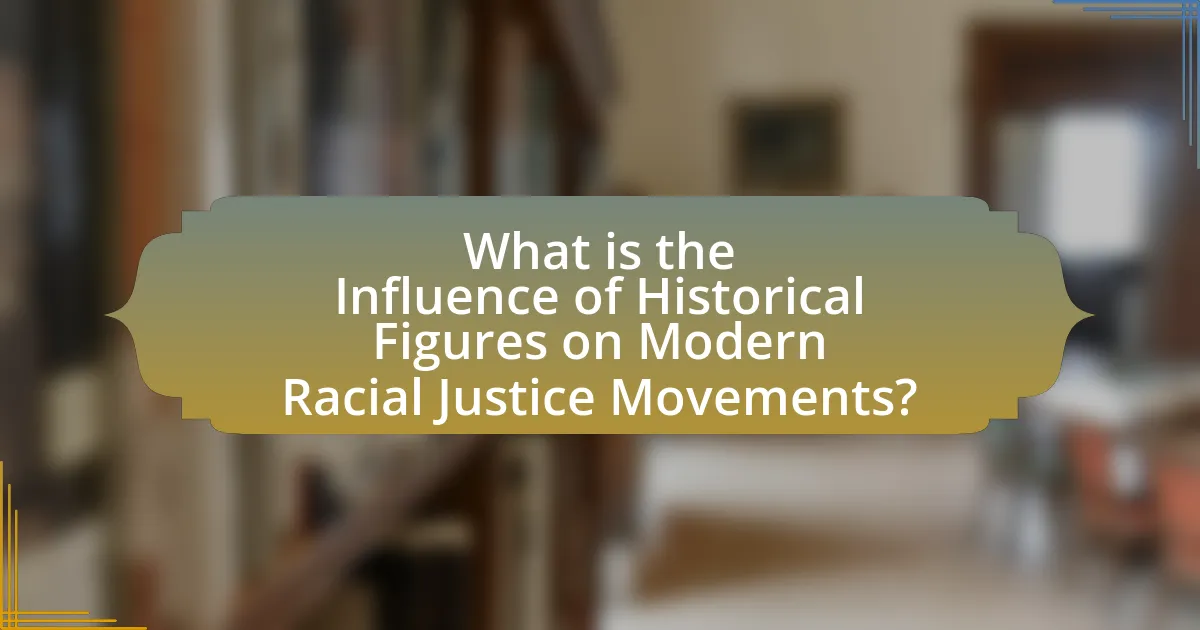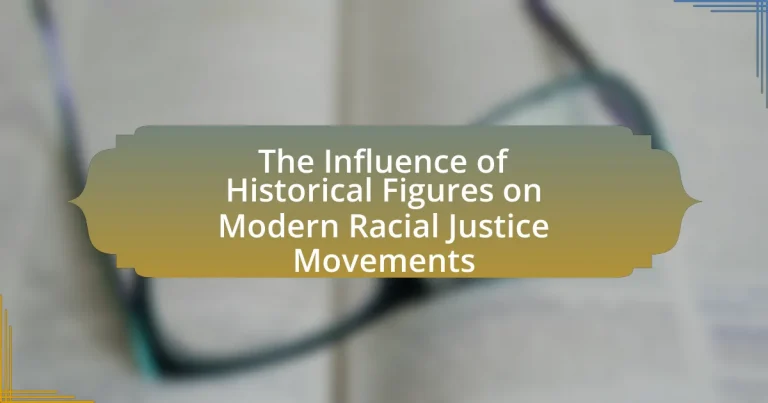The article examines the influence of historical figures on modern racial justice movements, highlighting key leaders such as Martin Luther King Jr., Malcolm X, and Rosa Parks. It discusses how their philosophies and strategies, including nonviolent protest and self-determination, continue to shape contemporary activism, particularly in movements like Black Lives Matter. The article also explores significant events that underscore these figures’ contributions, the relevance of their ideologies today, and the importance of understanding historical context in informing current racial justice strategies. Additionally, it addresses the role of education and media representation in shaping public perception of racial justice narratives.

What is the Influence of Historical Figures on Modern Racial Justice Movements?
Historical figures significantly influence modern racial justice movements by providing foundational philosophies, strategies, and inspiration. Leaders such as Martin Luther King Jr., Malcolm X, and Rosa Parks have shaped contemporary activism through their advocacy for civil rights, nonviolent protest, and the fight against systemic racism. For instance, King’s principles of nonviolent resistance continue to guide movements like Black Lives Matter, emphasizing peaceful protest as a means to achieve social change. Additionally, Malcolm X’s emphasis on self-determination and empowerment resonates with current activists advocating for racial equity. The historical context and strategies employed by these figures serve as blueprints for modern movements, demonstrating their lasting impact on the pursuit of racial justice today.
How have historical figures shaped the narrative of racial justice?
Historical figures have significantly shaped the narrative of racial justice by advocating for civil rights, challenging systemic racism, and inspiring future generations. For instance, Martin Luther King Jr. utilized nonviolent protest and eloquent speeches, such as his “I Have a Dream” address in 1963, to galvanize public support for racial equality and influence legislation like the Civil Rights Act of 1964. Similarly, figures like Rosa Parks and Malcolm X brought attention to racial injustices through their actions and ideologies, prompting societal reflection and change. Their contributions have established foundational narratives that continue to inform and motivate contemporary racial justice movements, demonstrating the lasting impact of their legacies on the fight for equality.
What key events highlight the contributions of these figures?
Key events that highlight the contributions of historical figures to modern racial justice movements include the 1963 March on Washington, where Martin Luther King Jr. delivered his iconic “I Have a Dream” speech, advocating for civil rights and equality. This event galvanized public support for the Civil Rights Act of 1964, which outlawed discrimination based on race, color, religion, sex, or national origin. Additionally, the 1965 Selma to Montgomery marches, led by figures like John Lewis, were pivotal in raising awareness about voting rights, ultimately leading to the Voting Rights Act of 1965. These events underscore the significant impact of these leaders in shaping contemporary racial justice initiatives.
How do their ideologies resonate with current movements?
The ideologies of historical figures like Martin Luther King Jr. and Malcolm X resonate with current movements by emphasizing themes of equality, justice, and systemic change. For instance, King’s advocacy for nonviolent protest and civil disobedience is mirrored in contemporary movements such as Black Lives Matter, which employs peaceful demonstrations to address police brutality and racial injustice. Similarly, Malcolm X’s focus on self-determination and empowerment influences current activists who advocate for community-led initiatives and economic independence. These ideologies are validated by the ongoing struggles against systemic racism, as evidenced by the increased visibility of racial justice issues in public discourse and policy reforms since the 2010s.
Why is understanding historical influence important for modern movements?
Understanding historical influence is crucial for modern movements because it provides context and lessons that shape current strategies and goals. Historical figures, such as Martin Luther King Jr. and Malcolm X, have laid foundational principles and tactics that inform contemporary racial justice movements. For instance, the Civil Rights Movement of the 1960s demonstrated the effectiveness of nonviolent protest, which continues to inspire modern activists. Additionally, analyzing past successes and failures allows current movements to adapt and refine their approaches, ensuring they are more effective in addressing systemic issues. This historical perspective not only fosters a sense of continuity but also empowers activists by connecting them to a legacy of struggle and resilience.
How does historical context inform current racial justice strategies?
Historical context informs current racial justice strategies by providing a framework for understanding systemic inequalities and the evolution of civil rights movements. For instance, the legacy of Jim Crow laws and the Civil Rights Movement of the 1960s highlight the persistent racial discrimination that informs contemporary advocacy efforts. Current strategies often draw on historical figures like Martin Luther King Jr. and Malcolm X, whose approaches to activism shape modern tactics, such as grassroots organizing and coalition-building. Additionally, historical events, such as the Voting Rights Act of 1965, serve as benchmarks for measuring progress and identifying ongoing challenges in racial equity. This historical awareness enables activists to tailor their strategies to address both historical injustices and current disparities, ensuring that movements remain relevant and impactful.
What lessons can modern activists learn from past leaders?
Modern activists can learn the importance of strategic nonviolent resistance from past leaders like Martin Luther King Jr. and Mahatma Gandhi. These leaders effectively utilized nonviolent methods to mobilize communities and draw attention to social injustices, demonstrating that peaceful protests can lead to significant change. For instance, King’s leadership during the Montgomery Bus Boycott in 1955 resulted in a Supreme Court ruling that declared segregation on public buses unconstitutional, showcasing the power of organized, nonviolent action. Additionally, Gandhi’s Salt March in 1930 highlighted how civil disobedience can challenge oppressive laws and inspire mass movements. By studying these historical examples, modern activists can understand the effectiveness of patience, coalition-building, and moral clarity in their campaigns for racial justice.

Who are the key historical figures influencing modern racial justice movements?
Key historical figures influencing modern racial justice movements include Martin Luther King Jr., Malcolm X, Rosa Parks, and Nelson Mandela. Martin Luther King Jr. is renowned for his leadership in the American civil rights movement, advocating for nonviolent resistance and delivering the iconic “I Have a Dream” speech in 1963, which galvanized public support for racial equality. Malcolm X, with his emphasis on Black empowerment and self-defense, challenged mainstream civil rights strategies and inspired a more militant approach to racial justice. Rosa Parks’ refusal to give up her bus seat in 1955 became a pivotal act of defiance that sparked the Montgomery Bus Boycott, a significant event in the civil rights movement. Nelson Mandela’s fight against apartheid in South Africa and his subsequent presidency symbolized the global struggle for racial justice, emphasizing reconciliation and equality. Each of these figures has left a lasting impact on contemporary movements advocating for racial justice and equality.
What roles did figures like Martin Luther King Jr. and Malcolm X play?
Martin Luther King Jr. and Malcolm X played pivotal roles in the American civil rights movement, each advocating for racial justice through distinct philosophies. Martin Luther King Jr. promoted nonviolent resistance and civil disobedience, exemplified by his leadership in events like the Montgomery Bus Boycott and the March on Washington, where he delivered his famous “I Have a Dream” speech in 1963, calling for equality and justice. In contrast, Malcolm X initially advocated for a more militant approach, emphasizing black nationalism and self-defense, particularly during his time with the Nation of Islam, and later sought to unite all oppressed people globally. Their differing strategies and ideologies significantly shaped the discourse on race relations in America, influencing contemporary movements for racial justice.
How did their approaches to racial justice differ?
Their approaches to racial justice differed primarily in their methods and philosophies. For instance, Martin Luther King Jr. advocated for nonviolent resistance and civil disobedience, emphasizing love and reconciliation, as seen in his leadership during the Montgomery Bus Boycott and the March on Washington. In contrast, Malcolm X promoted a more militant stance, advocating for self-defense and black nationalism, which he articulated in his speeches and writings, particularly during his time with the Nation of Islam. This fundamental difference in strategy reflects their distinct views on achieving racial equality and justice in America.
What lasting impacts did they have on contemporary activism?
Historical figures in racial justice movements have significantly shaped contemporary activism by establishing foundational strategies and ideologies that continue to inspire modern movements. For instance, the nonviolent resistance advocated by Martin Luther King Jr. has influenced contemporary protests, emphasizing peaceful demonstrations as a means to achieve social change. Additionally, the grassroots organizing techniques pioneered by figures like Ella Baker have been adopted by current movements, such as Black Lives Matter, which prioritize community engagement and decentralized leadership. The legacy of these historical figures is evident in the ongoing emphasis on intersectionality, as seen in contemporary activism that addresses multiple forms of oppression, reflecting the holistic approach championed by activists like Audre Lorde. Their contributions have created a framework that informs the tactics, goals, and philosophies of today’s racial justice movements, ensuring that their impact endures in the fight for equality and justice.
Which lesser-known figures have also made significant contributions?
Lesser-known figures who have made significant contributions to modern racial justice movements include Bayard Rustin, who was instrumental in organizing the 1963 March on Washington, and Ella Baker, a key strategist behind the Student Nonviolent Coordinating Committee (SNCC). Rustin’s advocacy for nonviolent protest and his role in civil rights activism helped shape the movement’s strategies, while Baker emphasized grassroots organizing and empowering local communities, influencing future generations of activists. Their contributions are often overshadowed by more prominent figures, yet their impact on the trajectory of racial justice is profound and enduring.
What movements did these figures inspire or lead?
Historical figures such as Martin Luther King Jr., Malcolm X, and Rosa Parks inspired or led significant movements for racial justice, including the Civil Rights Movement, Black Power Movement, and the Montgomery Bus Boycott. Martin Luther King Jr. was a central leader in the Civil Rights Movement, advocating for nonviolent protest and civil disobedience, which culminated in landmark legislation like the Civil Rights Act of 1964. Malcolm X’s advocacy for Black empowerment and self-defense galvanized the Black Power Movement, emphasizing racial pride and economic independence. Rosa Parks’ refusal to give up her bus seat sparked the Montgomery Bus Boycott, a pivotal event that highlighted systemic racism and mobilized communities for change. These movements collectively advanced the struggle for racial equality and justice in the United States.
How can their stories be integrated into modern discussions on racial justice?
Integrating the stories of historical figures into modern discussions on racial justice can be achieved by highlighting their contributions and the lessons learned from their struggles. For instance, the narratives of leaders like Martin Luther King Jr. and Rosa Parks can serve as powerful examples of resilience and activism, illustrating the ongoing fight against systemic racism. Their experiences can be contextualized within current movements, such as Black Lives Matter, to emphasize the continuity of the struggle for equality. Research shows that storytelling can enhance empathy and understanding, making historical accounts relevant to contemporary issues. By using these stories in educational settings, social media campaigns, and community discussions, modern activists can draw parallels between past and present injustices, fostering a deeper understanding of racial justice’s historical roots and its current implications.
How do historical figures’ legacies manifest in today’s racial justice movements?
Historical figures’ legacies manifest in today’s racial justice movements through the continued inspiration and frameworks they provide for activism. For instance, the teachings of Martin Luther King Jr. emphasize nonviolent resistance and civil disobedience, which are foundational strategies employed by contemporary movements like Black Lives Matter. Additionally, the work of figures such as Malcolm X has influenced a more assertive approach to racial justice, advocating for self-determination and empowerment within marginalized communities. These historical perspectives shape current dialogues around systemic racism, police brutality, and social equity, demonstrating their lasting impact on modern activism.
What modern movements draw direct inspiration from historical figures?
Modern movements such as Black Lives Matter and the Women’s March draw direct inspiration from historical figures like Martin Luther King Jr. and Susan B. Anthony. Black Lives Matter, founded in 2013, echoes King’s advocacy for civil rights and nonviolent protest against racial injustice, reflecting his principles in its mission to combat systemic racism. The Women’s March, initiated in 2017, channels Anthony’s fight for women’s suffrage and equality, emphasizing the ongoing struggle for women’s rights. Both movements utilize social media and grassroots organizing, similar to the strategies employed by their historical counterparts, to mobilize support and raise awareness on issues of racial and gender equality.
How do these movements honor or reinterpret their legacies?
Modern racial justice movements honor and reinterpret the legacies of historical figures by actively incorporating their principles and strategies into contemporary activism. For instance, movements like Black Lives Matter draw inspiration from the civil rights activism of figures such as Martin Luther King Jr. and Malcolm X, emphasizing nonviolent protest and direct action as means to combat systemic racism. Additionally, these movements reinterpret legacies by adapting historical narratives to address current issues, such as police brutality and racial inequality, thereby ensuring that the struggles of past leaders resonate with today’s social justice challenges. This connection is evident in the use of slogans and tactics that echo the past while addressing modern contexts, reinforcing the ongoing relevance of these historical figures in the fight for racial equity.
What symbols or slogans connect modern activists to historical figures?
Modern activists often connect to historical figures through symbols and slogans such as “Black Lives Matter,” which echoes the civil rights movement’s rallying cry for equality and justice. This slogan directly relates to the work of leaders like Martin Luther King Jr., who advocated for racial equality and justice in the 1960s. Additionally, the raised fist symbol, used during the Black Power movement, continues to represent solidarity and resistance against oppression, linking contemporary movements to figures like Angela Davis and the Black Panther Party. These connections illustrate how modern activism draws inspiration from historical struggles for racial justice, reinforcing the ongoing fight against systemic racism.
How do historical narratives influence public perception of racial justice?
Historical narratives significantly shape public perception of racial justice by framing the context and understanding of past injustices and struggles. These narratives often highlight key events, figures, and movements that have defined racial relations, such as the Civil Rights Movement, which informs contemporary discussions on equality and justice. For instance, the portrayal of Martin Luther King Jr. as a peaceful advocate for change influences how society views current racial justice efforts, often emphasizing nonviolent protest as a legitimate method for achieving social change. Furthermore, historical accounts that acknowledge systemic racism and its long-term effects, such as redlining and segregation, help the public recognize the ongoing impact of these injustices, thereby fostering a greater urgency for reform. Studies, such as those conducted by the Pew Research Center, indicate that individuals who are educated about historical racial injustices are more likely to support policies aimed at addressing racial disparities today.
What role does education play in shaping these narratives?
Education plays a crucial role in shaping narratives by providing individuals with the knowledge and critical thinking skills necessary to understand historical contexts and contemporary issues related to racial justice. Through curricula that include the study of historical figures and their contributions to social movements, education fosters awareness of systemic inequalities and empowers students to engage in advocacy. For instance, research by the Southern Poverty Law Center highlights that students exposed to comprehensive lessons on civil rights leaders, such as Martin Luther King Jr. and Malcolm X, demonstrate a greater understanding of racial justice issues and are more likely to participate in activism. This educational foundation not only informs personal beliefs but also influences collective societal narratives surrounding race and justice.
How can media representation affect the understanding of historical influences?
Media representation significantly shapes the understanding of historical influences by framing narratives that highlight or obscure specific events and figures. For instance, the portrayal of civil rights leaders like Martin Luther King Jr. in documentaries and films often emphasizes their nonviolent approach, which can influence public perception of the broader civil rights movement and its complexities. Research indicates that media narratives can create a simplified understanding of historical events, as seen in the representation of the Black Lives Matter movement, which sometimes overlooks the historical context of systemic racism and the contributions of earlier activists. This selective representation can lead to a skewed understanding of the past, affecting how current racial justice movements are perceived and supported.
What practical strategies can activists use to leverage historical influences?
Activists can leverage historical influences by drawing parallels between past movements and current struggles, utilizing historical narratives to inspire and mobilize support. For instance, referencing the civil rights movement led by figures like Martin Luther King Jr. can provide a framework for contemporary activism, emphasizing nonviolent resistance and community organizing. Historical examples, such as the successful mobilization strategies used during the Montgomery Bus Boycott, can inform modern tactics, demonstrating the effectiveness of sustained grassroots efforts. Additionally, activists can use archival materials, speeches, and writings from historical figures to educate and engage new audiences, fostering a sense of continuity and purpose in their cause. This approach not only honors the legacy of past leaders but also reinforces the relevance of their strategies in addressing ongoing racial injustices.
How can storytelling be used to connect past and present movements?
Storytelling can connect past and present movements by illustrating shared struggles and values, thereby fostering a sense of continuity and solidarity. For instance, narratives about historical figures like Martin Luther King Jr. and their fight for civil rights resonate with contemporary racial justice movements, such as Black Lives Matter, by highlighting ongoing issues of systemic racism and inequality. This connection is reinforced through the use of quotes, speeches, and personal anecdotes that evoke emotional responses and inspire action, demonstrating that the fight for justice is a persistent and collective endeavor.
What resources are available for activists to learn about historical figures?
Activists can access a variety of resources to learn about historical figures, including biographies, documentaries, academic journals, and online databases. Biographies provide in-depth insights into the lives and contributions of influential figures, while documentaries visually depict their impact and context. Academic journals often contain research articles that analyze the significance of these figures in social movements, offering critical perspectives and historical context. Online databases, such as JSTOR and Google Scholar, allow activists to find scholarly articles and primary sources related to historical figures, enhancing their understanding of their roles in racial justice movements. These resources collectively support activists in gaining a comprehensive understanding of the historical context and contributions of key figures in the fight for racial justice.


